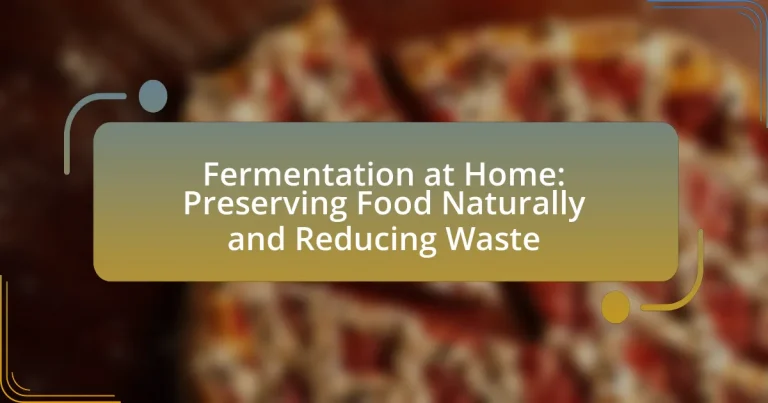Fermentation at home is the process of using microorganisms to convert sugars and starches in food into acids, gases, or alcohol, thereby preserving food and enhancing its flavor. This article explores the principles of fermentation, the types of microorganisms involved, and the importance of fermentation for food preservation and waste reduction. It also outlines various methods for home fermentation, including lacto-fermentation and alcoholic fermentation, while providing practical guidance on fermenting vegetables and beverages. Additionally, the article addresses the environmental benefits of home fermentation, such as reducing food waste and promoting sustainability, and offers tips for successful fermentation practices.

What is Fermentation at Home?
Fermentation at home is the process of using microorganisms, such as bacteria and yeast, to convert sugars and starches in food into acids, gases, or alcohol, thereby preserving the food and enhancing its flavor. This method has been utilized for centuries across various cultures to create products like yogurt, sauerkraut, and kombucha, which not only extend shelf life but also improve nutritional value by increasing probiotics. The effectiveness of home fermentation is supported by historical practices and scientific studies that demonstrate its role in food preservation and waste reduction.
How does fermentation work in home settings?
Fermentation in home settings involves the metabolic process where microorganisms like yeast and bacteria convert sugars into acids, gases, or alcohol under anaerobic conditions. This process is utilized to preserve food, enhance flavors, and improve digestibility. For example, in making sauerkraut, shredded cabbage is mixed with salt, which draws out moisture and creates an environment conducive to lactic acid bacteria. These bacteria ferment the sugars in the cabbage, producing lactic acid that acts as a preservative. Studies show that fermented foods can have health benefits, including improved gut health due to the presence of probiotics.
What are the basic principles of fermentation?
The basic principles of fermentation involve the conversion of sugars into acids, gases, or alcohol through the action of microorganisms such as bacteria, yeast, or molds. This metabolic process occurs in anaerobic conditions, meaning it takes place without oxygen. For example, in lactic acid fermentation, bacteria convert lactose into lactic acid, which is essential in producing yogurt and sauerkraut. Similarly, yeast ferments sugars into ethanol and carbon dioxide, a process crucial for brewing beer and baking bread. These principles not only enhance food preservation but also improve flavor and nutritional value, as seen in traditional fermented foods.
What types of microorganisms are involved in fermentation?
The types of microorganisms involved in fermentation include bacteria, yeasts, and molds. Lactic acid bacteria, such as Lactobacillus, are responsible for fermenting dairy products and vegetables, while yeasts like Saccharomyces cerevisiae are crucial for alcoholic fermentation and bread-making. Molds, particularly Aspergillus oryzae, are used in the fermentation of soy products like soy sauce. These microorganisms convert sugars into acids, gases, or alcohol, which are essential for the preservation and flavor development in fermented foods.
Why is fermentation important for food preservation?
Fermentation is important for food preservation because it inhibits the growth of spoilage microorganisms and pathogens through the production of acids, alcohol, and other compounds. This process not only extends the shelf life of food but also enhances its safety and nutritional value. For instance, lactic acid bacteria, which are commonly involved in fermentation, lower the pH of food, creating an environment that is hostile to harmful bacteria. Historical evidence shows that fermented foods like sauerkraut and yogurt have been consumed for centuries as effective preservation methods, demonstrating their long-standing role in food safety and longevity.
How does fermentation extend the shelf life of food?
Fermentation extends the shelf life of food by creating an environment that inhibits the growth of spoilage microorganisms. During fermentation, beneficial bacteria and yeasts convert sugars into acids, gases, or alcohol, which lowers the pH of the food. This acidic environment is hostile to pathogens and spoilage organisms, effectively preserving the food. For example, in the fermentation of vegetables, lactic acid bacteria produce lactic acid, which can lower the pH to around 4.6 or lower, significantly reducing the risk of spoilage. Additionally, fermented foods often contain natural preservatives and antioxidants that further enhance their longevity.
What role does fermentation play in enhancing flavors?
Fermentation enhances flavors by transforming raw ingredients through microbial activity, which produces a variety of compounds that contribute to taste and aroma. During fermentation, microorganisms such as bacteria, yeast, and molds break down sugars and starches, resulting in the creation of acids, alcohols, and gases that intensify and diversify flavors. For example, lactic acid bacteria in yogurt fermentation produce lactic acid, which imparts a tangy flavor, while yeast in bread fermentation generates alcohol and carbon dioxide, contributing to the bread’s texture and taste. This process not only enriches the sensory profile of food but also increases its complexity, making it more appealing to consumers.
What are the environmental benefits of home fermentation?
Home fermentation offers significant environmental benefits, primarily by reducing food waste and minimizing reliance on commercial food production. By fermenting surplus fruits and vegetables at home, individuals can preserve food that might otherwise spoil, thus decreasing the amount of organic waste sent to landfills. According to the Food and Agriculture Organization, approximately one-third of all food produced globally is wasted, contributing to greenhouse gas emissions. Additionally, home fermentation reduces the carbon footprint associated with transporting and packaging commercially produced fermented foods, as it encourages local consumption and self-sufficiency. This practice also promotes biodiversity by allowing the use of various local ingredients, which can support sustainable agricultural practices.
How does fermentation help in reducing food waste?
Fermentation helps in reducing food waste by transforming perishable food items into longer-lasting products through microbial activity. This process not only extends the shelf life of foods like vegetables and dairy but also enhances their nutritional value and flavor. For instance, fermented foods such as sauerkraut and yogurt can be stored for months, significantly decreasing the likelihood of spoilage. According to a study published in the journal “Waste Management,” fermentation can reduce food waste by up to 30% by allowing consumers to utilize surplus produce that might otherwise be discarded.
What impact does home fermentation have on sustainability?
Home fermentation significantly enhances sustainability by reducing food waste and promoting local food production. This process allows individuals to preserve surplus fruits and vegetables, thereby minimizing the amount of food that would otherwise be discarded. According to a study published in the journal “Waste Management,” approximately 30-40% of the food supply in the United States is wasted, and home fermentation can directly address this issue by extending the shelf life of perishable items. Additionally, home fermentation encourages the use of seasonal and locally sourced ingredients, which reduces the carbon footprint associated with transporting food over long distances. By engaging in home fermentation, individuals contribute to a more sustainable food system that emphasizes waste reduction and local sourcing.

What are the different methods of home fermentation?
The different methods of home fermentation include lacto-fermentation, alcoholic fermentation, and acetic acid fermentation. Lacto-fermentation utilizes lactic acid bacteria to preserve vegetables, fruits, and dairy products, creating foods like sauerkraut and yogurt. Alcoholic fermentation involves yeast converting sugars into alcohol and carbon dioxide, commonly used in brewing beer and making wine. Acetic acid fermentation transforms alcohol into vinegar through the action of acetic acid bacteria, resulting in products like apple cider vinegar. Each method relies on specific microorganisms to achieve fermentation, which enhances flavor, preserves food, and promotes beneficial probiotics.
How can I ferment vegetables at home?
To ferment vegetables at home, start by selecting fresh vegetables, such as cabbage, carrots, or cucumbers, and wash them thoroughly. Next, chop or shred the vegetables and mix them with salt, typically using about 2-3% salt by weight of the vegetables. This salt concentration helps draw out moisture and creates an environment conducive to fermentation. Pack the salted vegetables tightly into a clean glass jar, ensuring they are submerged in their own brine to prevent mold growth. Seal the jar with a lid or cover it with a cloth, allowing it to ferment at room temperature for several days to weeks, depending on the desired flavor and texture. Regularly check for bubbles and taste the vegetables to determine when they have reached the preferred level of fermentation. This method is supported by the fact that lactic acid bacteria, which thrive in salty environments, are responsible for the fermentation process, preserving the vegetables and enhancing their nutritional value.
What are the steps for making fermented pickles?
To make fermented pickles, follow these steps: First, prepare cucumbers by washing them and cutting off the ends. Next, create a brine by dissolving salt in water, typically using a ratio of 1-3 tablespoons of salt per quart of water. Submerge the cucumbers in the brine, ensuring they are fully covered, and add spices like garlic, dill, or peppercorns for flavor. Place a weight on top to keep the cucumbers submerged and cover the container with a cloth or lid to allow gases to escape. Ferment the pickles at room temperature for 1 to 4 weeks, tasting periodically until they reach the desired sourness. Once fermented, transfer the pickles to the refrigerator to slow down the fermentation process. This method leverages the natural fermentation process, which has been used for centuries to preserve food and enhance flavors.
What safety precautions should I take when fermenting vegetables?
When fermenting vegetables, it is crucial to maintain cleanliness to prevent harmful bacteria growth. Start by thoroughly washing hands, utensils, and containers with hot, soapy water. Use fresh, high-quality vegetables and ensure they are free from bruises or rot, as damaged produce can harbor pathogens. Additionally, ferment in a cool, dark place to inhibit the growth of undesirable microorganisms; temperatures between 60°F and 75°F are ideal. Monitoring the fermentation process is essential; if any off smells, colors, or mold appear, discard the batch immediately. Following these precautions helps ensure safe fermentation and reduces the risk of foodborne illness.
What are the techniques for fermenting beverages?
The techniques for fermenting beverages include natural fermentation, controlled fermentation, and the use of starter cultures. Natural fermentation relies on wild yeast and bacteria present in the environment, allowing spontaneous fermentation to occur, as seen in traditional methods for making beverages like mead and cider. Controlled fermentation involves managing temperature, pH, and oxygen levels to optimize yeast activity, commonly used in brewing beer and winemaking. Starter cultures, which are specific strains of yeast or bacteria, are added to initiate fermentation, ensuring consistency and desired flavor profiles, as practiced in the production of yogurt and kefir. These techniques are validated by their historical use and the scientific understanding of microbial activity in fermentation processes.
How do I make homemade kombucha?
To make homemade kombucha, start by brewing sweetened tea using black or green tea and sugar, then allow it to cool. Once cooled, add a SCOBY (Symbiotic Culture of Bacteria and Yeast) and some starter tea from a previous batch. Cover the jar with a cloth and secure it with a rubber band, then let it ferment at room temperature for 7 to 14 days. The fermentation time affects the flavor; longer fermentation results in a more tangy taste. After fermentation, remove the SCOBY, bottle the kombucha, and optionally add flavors like fruit or herbs before refrigerating. This method is validated by the traditional practice of kombucha brewing, which has been used for centuries to create a probiotic-rich beverage.
What is the process for brewing kefir at home?
To brew kefir at home, combine milk with kefir grains in a clean glass jar, using a ratio of about 1 tablespoon of grains per cup of milk. Cover the jar with a breathable cloth secured with a rubber band to allow airflow while preventing contaminants. Let the mixture sit at room temperature for 24 to 48 hours, during which the kefir grains ferment the milk, thickening it and developing a tangy flavor. After fermentation, strain the kefir to separate the grains, which can be reused for future batches. The resulting kefir can be stored in the refrigerator for up to two weeks. This process is validated by the traditional methods of kefir preparation, which have been used for centuries in various cultures.
What equipment do I need for home fermentation?
To successfully engage in home fermentation, you need several essential pieces of equipment: fermentation vessels, airlocks, weights, and a thermometer. Fermentation vessels, such as glass jars or food-grade plastic containers, provide a controlled environment for the fermentation process. Airlocks allow gases to escape while preventing contaminants from entering, ensuring a safe fermentation. Weights are used to keep the fermenting food submerged in the liquid, which is crucial for anaerobic fermentation. A thermometer helps monitor the temperature, as it significantly affects the fermentation process. These tools are fundamental for achieving optimal results in home fermentation.
What are the essential tools for fermenting food?
The essential tools for fermenting food include fermentation vessels, weights, airlocks, and pH meters. Fermentation vessels, such as glass jars or ceramic crocks, provide a controlled environment for the fermentation process. Weights are used to keep food submerged in the brine, preventing exposure to air and mold growth. Airlocks allow gases to escape while preventing outside air from entering, which is crucial for anaerobic fermentation. pH meters help monitor acidity levels, ensuring the safety and quality of the fermented product. These tools are fundamental for successful fermentation, as they create optimal conditions for beneficial bacteria to thrive while minimizing the risk of spoilage.
How can I create a suitable fermentation environment at home?
To create a suitable fermentation environment at home, maintain a consistent temperature between 60°F to 75°F (15°C to 24°C), as this range is optimal for most fermentation processes. Additionally, ensure that the area is dark and free from direct sunlight, which can inhibit fermentation. Use clean, sterilized containers to prevent contamination, and cover them with breathable materials like cheesecloth to allow airflow while keeping out pests. The presence of beneficial microorganisms, such as those found in starter cultures or naturally occurring in vegetables, is crucial for successful fermentation. Studies show that maintaining these conditions can enhance the growth of desired bacteria and yeasts, leading to effective fermentation outcomes.

What challenges might I face when fermenting at home?
When fermenting at home, you may face challenges such as maintaining the correct temperature, ensuring proper sanitation, and managing the fermentation time. Temperature control is crucial because most fermentation processes require specific ranges to promote the growth of beneficial microorganisms while inhibiting harmful ones. For example, temperatures that are too high can lead to spoilage, while those that are too low can slow down fermentation.
Sanitation is another significant challenge; improper cleaning of equipment can introduce unwanted bacteria, leading to failed fermentation or foodborne illnesses. Additionally, managing fermentation time is essential, as over-fermentation can result in undesirable flavors and textures. According to a study published in the Journal of Food Science, improper fermentation conditions can lead to the growth of pathogens, emphasizing the importance of monitoring these factors closely.
What common mistakes should I avoid in home fermentation?
Common mistakes to avoid in home fermentation include inadequate sanitation, improper temperature control, and using the wrong ingredients. Inadequate sanitation can lead to contamination, which may spoil the fermentation process; studies show that maintaining a clean environment is crucial for successful fermentation. Improper temperature control can hinder the fermentation process, as most fermentations require specific temperature ranges to thrive; for example, many vegetable ferments prefer temperatures between 60°F and 75°F. Lastly, using the wrong ingredients, such as non-organic produce with pesticides, can negatively impact the flavor and safety of the final product.
How can I troubleshoot fermentation issues?
To troubleshoot fermentation issues, first assess the fermentation environment, including temperature, pH, and oxygen levels, as these factors significantly impact yeast and bacteria activity. For instance, maintaining a temperature between 68°F and 72°F is ideal for most fermentations, while extreme temperatures can inhibit fermentation or lead to off-flavors. Additionally, ensure that the pH is within the optimal range for the specific fermentation process, typically around 4.0 to 4.6 for vegetable ferments, as improper pH can hinder microbial growth.
If fermentation is slow or stalled, check for adequate yeast viability by ensuring the yeast is fresh and properly activated. A common issue is insufficient sugar content; therefore, verify that there is enough fermentable sugar in the mixture. If off-flavors develop, consider the possibility of contamination from unwanted microorganisms, which can be mitigated by maintaining cleanliness and proper sanitation practices throughout the fermentation process.
Monitoring these variables and making adjustments as necessary can effectively resolve most fermentation issues.
What signs indicate that fermentation has gone wrong?
Signs that indicate fermentation has gone wrong include off-putting odors, unusual colors, and the presence of mold. Off-putting odors, such as a strong, foul smell, suggest the growth of undesirable bacteria, while unusual colors, like pink or green, can indicate spoilage. The presence of mold, particularly if it is fuzzy or discolored, is a clear sign that the fermentation process has failed. These indicators are critical for ensuring food safety during home fermentation, as they help identify potential health risks associated with consuming spoiled products.
How can I ensure successful fermentation results?
To ensure successful fermentation results, maintain optimal temperature, use quality ingredients, and ensure proper sanitation. Fermentation thrives at specific temperatures, typically between 60°F to 75°F, which promotes the growth of beneficial microorganisms while inhibiting harmful bacteria. Using fresh, high-quality ingredients, such as organic vegetables and pure cultures, enhances the fermentation process by providing the necessary nutrients for microorganisms. Additionally, proper sanitation of equipment and containers prevents contamination, which can spoil the fermentation. Studies show that maintaining these conditions significantly increases the likelihood of achieving desired fermentation outcomes, as evidenced by successful home fermentation practices documented in various food science research.
What tips can help improve my fermentation process?
To improve your fermentation process, maintain a consistent temperature between 65°F and 75°F, as this range promotes optimal microbial activity. Fermentation relies on specific microorganisms, such as yeast and bacteria, which thrive within this temperature range, ensuring effective fermentation. Additionally, using high-quality ingredients, such as fresh vegetables and pure cultures, enhances flavor and fermentation efficiency. Research indicates that the use of non-iodized salt, at a concentration of 2-3%, can inhibit undesirable bacteria while promoting the growth of beneficial ones, further improving the fermentation outcome.
How do I know when my fermented food is ready to eat?
Fermented food is ready to eat when it has developed a tangy flavor and a pleasant aroma, indicating that the fermentation process is complete. Typically, this occurs within a specific timeframe depending on the type of food and fermentation conditions; for example, sauerkraut usually takes about 1 to 4 weeks at room temperature. Additionally, visual cues such as bubbles or a change in color can signal readiness. Taste testing is also a reliable method; if the food tastes sour and has a desired texture, it is likely ready for consumption.
What are some best practices for fermenting at home?
To successfully ferment at home, ensure you use clean equipment, maintain proper temperatures, and select the right ingredients. Cleanliness prevents unwanted bacteria from contaminating the fermentation process, while maintaining a temperature between 60°F and 75°F promotes optimal fermentation. Additionally, using fresh, high-quality ingredients enhances flavor and fermentation efficiency. Research indicates that proper sanitation and temperature control significantly improve the quality and safety of fermented foods, as noted in studies on home fermentation practices.
How can I experiment with flavors in my fermentation?
To experiment with flavors in your fermentation, you can introduce various ingredients such as herbs, spices, fruits, or vegetables during the fermentation process. This method allows you to create unique flavor profiles tailored to your preferences. For example, adding garlic or dill can enhance the taste of pickles, while incorporating ginger or citrus can add zest to kombucha. The fermentation process itself can also alter flavors; for instance, longer fermentation times can deepen and complexify the taste. Additionally, using different types of sugars or yeasts can lead to distinct flavor outcomes, as certain strains of yeast produce specific flavor compounds.
What resources are available for learning more about home fermentation?
Books, online courses, and community workshops are valuable resources for learning about home fermentation. Notable books include “The Art of Fermentation” by Sandor Katz, which provides comprehensive insights into various fermentation techniques and their historical context. Online platforms like Coursera and Udemy offer structured courses on fermentation, often featuring expert instructors. Additionally, local community centers or farmers’ markets frequently host workshops that allow hands-on experience in fermentation practices, fostering a practical understanding of the process. These resources collectively enhance knowledge and skills in home fermentation, promoting food preservation and waste reduction.


